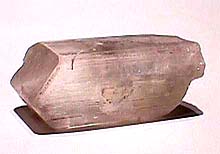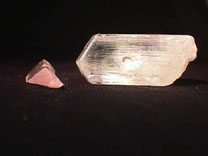A free gemology reference site
Gemology, gemstones, minerals and more
The Gemstones
Kunzite (spodumene)
Consumer Information
What color is it?: Kunzite is pink to violet/pink in color. Other colors of the spodumene group will be various colors of green which is called hiddenite.
What is the story behind this gemstone?: It was named after a world renowned gemologist, Mr. G. F Kunz who first found the stone in 1902. It can occur in very large crystals weighing several kilograms. It is rather soft, sort of brittle, and will lose its color in sunlight....but we will discuss that later.
Can I wear it everyday?: Well, sort of. Kunzite is heated to enhance the light pink colors to a darker pink. And if it is exposed to sunlight it has a strong tendency to fade. So if the question is: Can I wear it everyday? The answer is: No. But if the question is: Can I wear it every night? The answer is: Yes. Just be careful because it is sort of brittle.
Is it expensive?: It can be. Kunzites of deep pink color will be rather pricey. In line with a fine pink topaz.
Is it a birthstone?: No.
What do I need to know before going shopping?: Kunzite was very, very popular in the early 1980's. However, after buying a lot of the stones consumers realized that they were fading in color when worn in the bright sunlight. So the excitement sort of faded....along with the color. But if you are aware of the limitations of owning a nice kunzite they are beautiful stones.
General Information
Source: Brazil, Burma, United States among others
Chemical: LiAl(Si2O6) lithium aluminum silicate
Formation: In pegmatite dikes and granite formations
Crystal System: Monoclinic
Unusual Properties: Strong Fluorescence
Gemological Information
RI: 1.660 - 1.676
Birefringence: .016
Optic Character: B +
Specific Gravity: 3.17 + -
Hardness: 6.5 + -
Transparency: TP
Special Identifying Properties and Tests: Strong pleochroism possible. Perfect cleavage makes faceting difficult.
Synthetics: None known
Imitations: Many possible.


